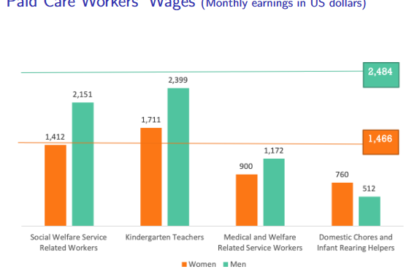
Care work, whether unpaid or paid, lies at the heart of humanitarian concern and expression, and our societies and economies are dependent on it to survive and thrive. Across the world, women account for more than three-quarters of the total amount of unpaid care time while two-thirds of paid care workers are women (Folbre et al. 2012; ILO 2018; Yoon et al. 2011).The outsized role that women play in providing care is readily observed in South Korea, with its strong patriarchal and familistic orientation that assigns primary responsibility for the care of children and elderly to women in the household, reinforcing the economic significance of gender. While unpaid care work by family members, especially women, makes up a large part of the care provided within Korean society, the rapid aging of the population and the fact that more than 50% of the female population aged 16 and older participated in the labor force in 2016-18 underscore the importance of paid care workers in meeting care needs(ILO 2018).They tend to the most basic necessities and help sustain the well-being of those in dependent positions, such as children, frail elderly, or people with illness and/or disabilities. Broadly, there is a spectrum of paid workers providing care, ranging from informal workers such as domestic service workers, nannies, and home care aides in private homes to formal workers in child care centers, nurseries and early childhood learning centers, elder care centers, nursing homes, and assisted living facilities, to nurses and teachers.
Accounting for the contribution of paid care workers is crucial to our understanding of the centrality of care in the development of human capabilities and economic progress; itis a crucial part of the effort to make women’s work and all forms of care work more visible. As the ILO (2018) points out, “care workers close the circle between unpaid care provision and paid work” (p.166). It is also critical to understand their work conditions since they represent one of 5the fastest growing segments of the labor force. For that reason, it is of particular concern that the paid care workforce experience slow wages and difficult working conditions across occupations and industries (ILO 2018). For instance, domestic workers are most vulnerable to exploitation and abuse among all workers in the labor market (UNDP 2015), a consequence of their frequent exclusion from laws and regulations affording labor protections. Understanding paid care work is therefore critical to shedding light on the implications of economic, cultural, and policy contexts that shape the larger labor market as well.
Suh (2019) provides a comprehensive picture of the paid care workforce in South Korea by measuring its size and extrapolating the median wage earnings and aggregate hours spent on care-giving by the workers using following data sources: the Local Area Labor Force Survey, Child Care Statistics, Social Services Voucher Statistics, and Long-term Care Insurance Statistical Yearbook for 2009 and 2014. The size of the paid care workforce in South Korea in this estimation focuses on the value of the labor provided by care workers that are directly and indirectly involved in elder care and childcare provision. The estimation will be used for making the paid care sector visible in the Korean Social Accounting Matrix (SAM), which serves as the base for developing the GAM Care Computable General Equilibrium (CGE) model for policy analysis.
This paper will be available December 2019
